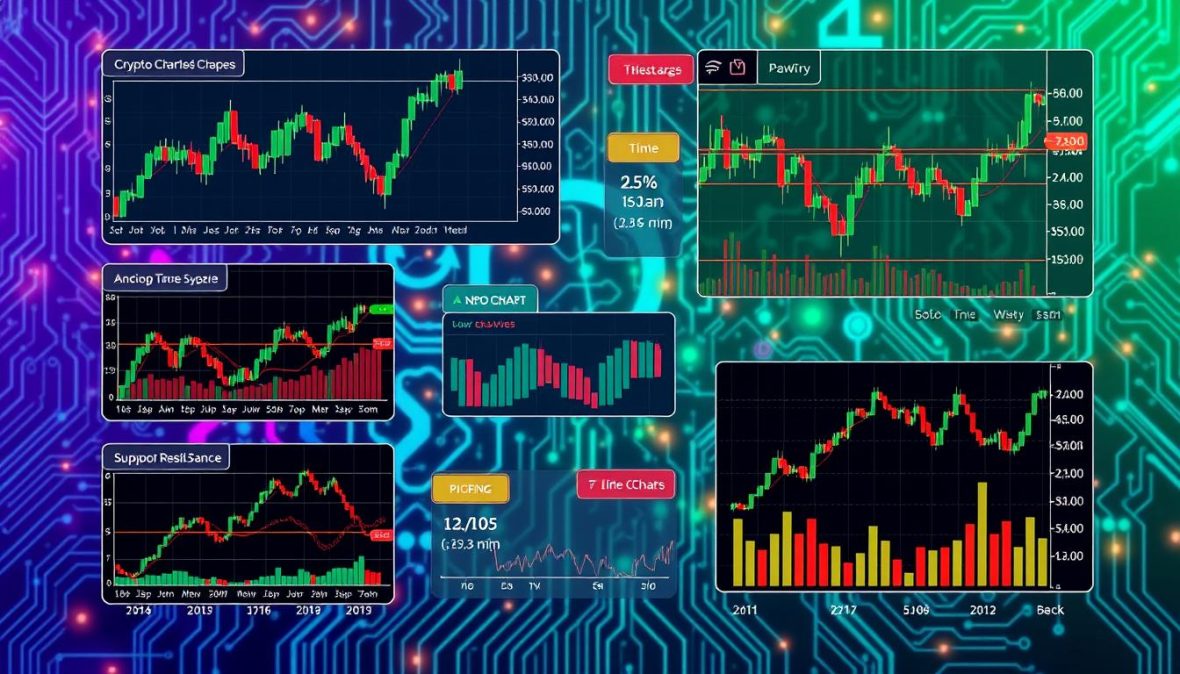Understand How to Read Crypto Charts Effectively

Did you know about 70% of traders turn to crypto charts for smart decisions? Getting the hang of reading these charts is key in the fast-paced digital asset world. This guide will share tips on understanding crypto chart analysis, focusing on its different parts and strategies. These can up your game in reading crypto graphs.
As you explore the world of cryptocurrency charts, you’ll uncover trends, patterns, and helpful indicators. These are important whether you’re starting out or improving your trading skills. By mastering these, you can boost your success in trading. Join us as we dive into the necessary skills to successfully maneuver through the crypto market.
Key Takeaways
- Reading crypto charts is essential for making informed trading decisions.
- Understanding different chart types enhances cryptocurrency chart analysis.
- Identifying trends and patterns is crucial for successful trading.
- Utilizing indicators aids in interpreting crypto graphs more accurately.
- Practical applications of chart readings can improve trading strategies.
Introduction to Crypto Charts
Learning to read crypto charts is key for anyone entering the digital currency space. These charts show price changes over time, helping traders see trends. They’re vital for deciding when to buy or sell.
Crypto trading starts with chart interpretation. You’ll encounter line charts, bar charts, and candlestick charts. Each one can help you understand market movements. They also show trading volume and market dynamics, key for good decisions.
As you get better at chart analysis, you’ll see its value in trading. Reading these charts is the first big step. It sets you up to explore the complex world of cryptocurrencies. Start with these basics to navigate the market confidently.
Key Components of Cryptocurrency Charts
Getting to know cryptocurrency charts is key for trading and investment. It’s important to understand the setup of price axes and timeframes. Also, knowing how to spot volume trends gives you a peek into market behavior.
Understanding Price Axes and Timeframes
The price of cryptocurrency is shown on the vertical axis of a chart. The horizontal axis shows the time. These elements help you understand market moves. For example, short periods like hours or days show quick changes. Longer periods show steadier trends. This knowledge is crucial for analyzing cryptocurrency price movements.
Identifying Volume Trends
Volume trends show how much cryptocurrency is traded in a certain time. Spotting these trends tells you about the market’s strength. High trading volumes often mean a trend might keep going. While low volumes might mean less support. Knowing this helps you read crypto charts better, keeping you ready for market shifts.
How to Read Crypto Charts
Learning to read crypto charts is key for smart trading choices. Begin by examining price changes, looking for trends, and spotting important patterns. Notice the high and low prices, as they mark vital support or resistance levels.
During your analysis of cryptocurrency charts, keep an eye on the trading volume. It gives insights into price changes. For example, ParallelAI’s price jumped by 137% to $0.305 in a day. At the same time, trading volume increased by 318% to $2.5 million1. This info helps you grasp the market’s mood and future trends.
Always be on the lookout for specific chart patterns, like bullish U-shaped bottoms. The PAI/USDT chart showed a bullish breakout lately. Seeing if the price is above moving averages, like PAI’s price over the 50-day SMA at $0.14, hints at strong bullish feelings1.
The Relative Strength Index (RSI) at 81.30 might signal the market is overbought, suggesting a possible pullback1. A MACD chart with the blue line over the orange line confirms increasing momentum.
To analyze cryptocurrency charts well, mix price trends with volume changes for a full view. Paying attention to both charts and indicators sharpens your ability to understand crypto graphs. This gives you an advantage in the fast-moving crypto world.
New platforms like Memebet Casino and projects like Qubetics show the range of chances in crypto. Qubetics, for instance, raised about $1.25 million in presale. Its tokens went up from $0.01 to $0.0142. Knowing about new projects and market shifts is vital for improving your trading approach.
Understanding Price Trends in Cryptocurrencies
Understanding how prices change in cryptocurrencies is key to trading well. Keeping an eye on these changes helps you understand the market mood and make good choices. Prices in the crypto world tend to follow three main patterns: going up, going down, or staying steady.
Identifying Uptrends and Downtrends
An uptrend means prices are climbing, showing a strong market. This is seen through higher peaks and valleys in the price. Crypto chart reading techniques can help spot these. On the other hand, downtrends show prices falling, marked by lower peaks and valleys. This suggests a weak market that might lose value. Knowing these trends helps you plan better, whether you’re starting or stopping investments.
Recognizing Consolidation Patterns
When prices don’t change much, it’s called consolidation. This often happens right before a big price move. Watching for these quiet times can clue you into what might happen next. Traders use this info to shape smart trading plans. This way, they’re ready for whatever comes. Getting to know these patterns in crypto trading gives you insights into likely market moves.
Analyzing Digital Currency Charts
When you start to analyze digital currency charts, you’ll deal with two key parts. First are moving averages, and second are support and resistance levels. These are the core of technical analysis for crypto charts. They help you make smart trading choices.
Using Moving Averages for Analysis
Moving averages help smooth out price changes over time. They let you see trends clearly, ignoring day-to-day price jumps. You’ll see moving averages over 50 days or 200 days used often to check market trends. Seeing if the price is rising or falling becomes simpler. This makes it easier to understand digital currency charts.
Importance of Support and Resistance Levels
It’s vital to get support and resistance levels in trading. Support levels are where prices might start to climb because of increased buying. Resistance levels, meanwhile, show where prices might drop due to selling. Knowing these levels lets you guess when prices might change or keep moving. This knowledge boosts your confidence and strategies in crypto trading.
| Moving Averages | Support Levels | Resistance Levels |
|---|---|---|
| Smooths out price trends | Buying interest increases | Selling pressure intensifies |
| Common periods: 50-day, 200-day | Signal reversal points | Can indicate breakout opportunities |
| Helps identify market direction | Reflects historical price behavior | Guides trading decisions |
Mastering moving averages and understanding support and resistance helps a lot. It makes you much better at analyzing digital currency charts3.
Deciphering Cryptocurrency Charts
Learning to read cryptocurrency charts is key to smart investing in digital currency. Use different analytical techniques to understand price changes. Starting with trendlines helps identify key support and resistance zones. It’s the first step in knowing market direction and important price points.
Looking at volume trends is also critical when reading crypto charts. It can show you active market move that might change prices. Smart investors always look at past price trends. These trends can show important market hints that aren’t obvious at first.
Getting good at understanding crypto charts helps you make strategic moves in the market. This ability gives you an edge in the unpredictable world of crypto trading. Try out different charting tools and resources to get better at reading charts.
Interpreting Candlestick Patterns in Crypto Charts
Candlestick patterns give us a peek into market movements in the crypto world. They show the open, close, high, and low prices, helping predict what might happen next. Through different patterns, traders can sense if the market might change direction or keep going the same way.
Common Candlestick Patterns
There are a few candlestick patterns you need to know for crypto chart analysis. These are:
- Doji: This pattern shows when the market can’t decide which way to go.
- Engulfing: It might mean the market’s about to change direction. One candle completely covers the last one.
- Hammer: You see this at the end of a downturn, hinting at a possible comeback.
Knowing these patterns can really up your trading game and help you make smarter choices.
How Patterns Indicate Market Sentiment
Market mood is huge in crypto chart analysis, as it guides how traders act. Spotting the current mood helps you figure out when to buy or sell. For instance, seeing a strong candlestick then a doji could mean the buying rush is slowing, maybe pointing to a price drop ahead. Or, an engulfing pattern at a key price level might show strong buying interest, encouraging others to jump in. Getting these cues is key to being successful in the market.
Crypto Chart Reading Techniques
For traders looking to get better at understanding market movements, knowing how to read crypto charts is key. You’ll find tools like the Relative Strength Index (RSI), Bollinger Bands, and Moving Average Convergence Divergence (MACD) very useful. They help form your trading strategy by showing hidden market trends.
Utilizing Chart Indicators for In-depth Analysis
Adding chart indicators to your analysis helps figure out momentum, how much prices might jump around, and when they might change direction. The RSI points out if a crypto is bought or sold too much. Bollinger Bands track how prices move over time. These tools make understanding crypto charts much easier, making your analysis better.
Applying Technical Analysis for Better Insights
Technical analysis is vital for improving your trading strategies. It lets you mix data from different indicators with past performance to craft advanced strategies. This approach helps you make smart decisions, enhancing your trades.
Practical Applications of Chart Reading
Understanding chart reading in cryptocurrency can boost your trading success. Learning to read crypto charts gives insights into market trends. This helps you to make smart choices. Traders use chart readings to create strategies that fit their risk levels and goals.
How to Apply Chart Readings to Trading Strategies
Using what you learn from chart analysis can improve your cryptocurrency trading strategies. For example, following a big increase, like Bitcoin’s jump from $58,800 to $64,900, you might try day trading. It’s important to notice when prices stop moving much. Staying above $62,000 could mean the trend will keep going up, which is good for those who prefer to watch and wait4.
With Bitcoin near its all-time highs, understanding market psychology is key. If Bitcoin breaks past resistance at $66,500, you might plan for a rally to $73,0004. Using tools like DappRadar helps find airdrop opportunities and boosts your crypto holdings5.
As you get better at chart reading, try different trading strategies like swing trading or HODLing. Checking the market regularly lets traders change their plans to gain more and lose less. For instance, seeing strong buy walls means the market might go up. This can lead you to adjust your trading strategies for the better4.
Conclusion
Learning how to read crypto charts well is key in the fast-moving world of cryptocurrency. This guide has shown you the top techniques and tips for analyzing crypto charts. With these skills, you can understand market changes better, improving how you make decisions and plan trades.
Recent trends, like Retardio’s success on the Solana blockchain6, show how crucial market knowledge is. Plus, knowing about rules in places like Japan and the USA for crypto trades7 affects how you trade and invest. This info is important for your trading strategy.
Getting good at reading charts requires practice and a dedication to learning. The crypto market is always changing, so you need to keep up with new trends and movements. Use what you’ve learned from this guide to make smart choices in your crypto trading adventure.

